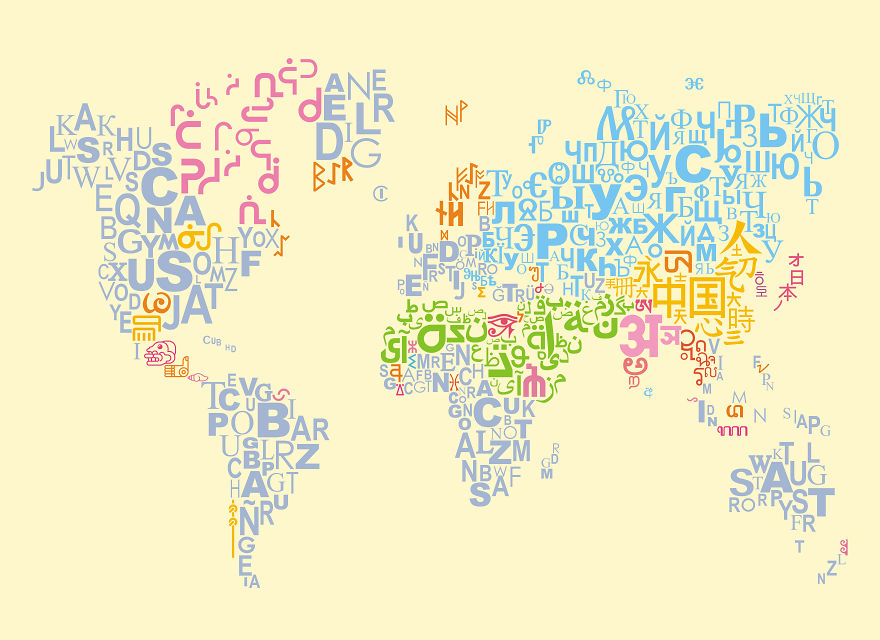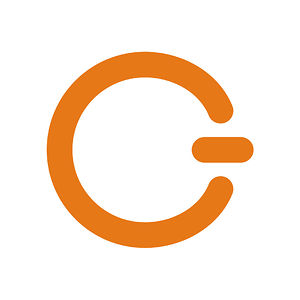We Are All Writers
120views
On the map, you can see the world’s most interesting scripts.
About 2.6 billion people (36%) use the Latin alphabet (gray), about 1.3 billion people (18%) use the Chinese script (yellow), about 1.2 billion people (16%) use the Devanagari alphabet (India- pink), about 1 billion people (14%) use the Arabic alphabet (green), about 0.3 billion people (4%) use the Cyrillic alphabet (blue) and about 0.25 billion people (3.5%) use the Dravidian script (South India).
MORE INTERESTING FACTS:
Inuktitut syllabics (Kanada– pink) is a writing system used by the Inuit in Nunavut and in Nunavik, Quebec. In 1976, the Language Commission of the Inuit Cultural Institute made it the co-official script for the Inuit languages, along with the Latin script.
Cree syllabics (Kanada-yellow) were created in 1840 by English missionary James Evans for two languages, Swampy Cree and Ojibwe. Syllabics were later adapted to several other languages (Inuktitut). It is estimated that over 70,000 Algonquian-speaking people use the script.
Sequoyah (c.1770—1843), was a Cherokee silversmith, who creates a Cherokee syllabary (USA – orange) in 1821. After seeing its worth, the people of the Cherokee Nation rapidly began to use his syllabary and officially adopted it in 1825. Their literacy rate quickly surpassed that of surrounding European-American settlers.
The Epi – Olmec (Mexico- yellow) culture was a cultural area in the central region of the present-day Mexican state of Veracruz. A culture that existed from roughly 300 BCE to roughly 250 CE. Epi-Olmec was a successor culture to the Olmec. Although Epi-Olmec did not attain the far-reaching achievements of that earlier culture, it did realize, with its sophisticated calendrics and writing system, a level of cultural complexity unknown to the Olmecs.
Aztec or Nahuatl writing (Mexico- red) is a pictographic and ideographic pre-Columbian writing system with a significant number of logograms and syllabic signs which were used by the Nahua people. The language that the Aztec spoke was called Nahuatl. The Aztecs, or Mexica as they called themselves, were militaristic empire centered in Central Mexico.
Maya writing (Mexico- orange) used logograms complemented by a set of syllabic glyphs, somewhat similar in function to modern Japanese writing. The Maya people created the longest lasting civilization of the Mesoamerica.
Quipus (South America-yellow), sometimes known as talking knots, were recording devices used from cultures in the region of Andean. A quipu usually consisted of colored, spun, and plied thread or strings made from cotton or camelid fiber. For the Inca, the system aided in collecting data and keeping records, calendrical information, and military organization.
The Elder Futhark (Scandinavia, Greenland- orange) is the oldest form of the runic alphabets. It was a writing system used by Vikings and Germanic tribes from the 2nd to 8th centuries. Vikings voyaged to points in North America, ca. 1000–1400, as they attempted to expand trade. Around the year 1000, several Viking expeditions established villages in North America. The settlements were quickly abandoned, leaving little evidence of their existence behind, though Vikings likely continued to voyage to the North American continent for several hundred years.
Ge’ez (also known as Ethiopic) is a script used for several languages of Ethiopia and Eritrea (East Afrika- pink). The earliest inscriptions of Semitic languages in Eritrea and Ethiopia date to the 9th century BC.
The ‘Phags-pa script (Mongolia- red) is an alphabet designed by the Tibetan monk and Imperial Preceptor Drogön Phagpa for Kublai Khan, the founder of the Yuan dynasty. The actual use of this script was limited to about a hundred years during the Mongol Yuan dynasty, and it fell out of use with the advent of the Ming dynasty.
The Sino-Tibetan languages, also known as Trans-Himalayan, are a family of more than 400 languages spoken in East Asia, Southeast Asia, and South Asia. Tibetan is one of the oldest Sino-Tibetan languages. The earliest Tibetan inscriptions date from 7th century CE. (over India- red)
The New Maori script (New Zealand-red) was created by Ian James in the late 20th century. In the case of Maori – unlike some languages – the Roman system is quite effective. So New Maori does not offer benefits of efficiency, simply those of cultural identity.
Info: https://en.wikipedia.org http://www.worldstandards.eu/other/alphabets/
More interesting designs- in our shop (link- under the map)
More info: society6.com
On the map, you can see the world’s most interesting scripts.
About 2.6 billion people (36%) use the Latin alphabet (gray), about 1.3 billion people (18%) use the Chinese script (yellow), about 1.2 billion people (16%) use the Devanagari alphabet (India- pink), about 1 billion people (14%) use the Arabic alphabet (green), about 0.3 billion people (4%) use the Cyrillic alphabet (blue) and about 0.25 billion people (3.5%) use the Dravidian script (South India).
MORE INTERESTING FACTS:
Inuktitut syllabics (Kanada– pink) is a writing system used by the Inuit in Nunavut and in Nunavik, Quebec. In 1976, the Language Commission of the Inuit Cultural Institute made it the co-official script for the Inuit languages, along with the Latin script.
Cree syllabics (Kanada-yellow) were created in 1840 by English missionary James Evans for two languages, Swampy Cree and Ojibwe. Syllabics were later adapted to several other languages (Inuktitut). It is estimated that over 70,000 Algonquian-speaking people use the script.
Sequoyah (c.1770—1843), was a Cherokee silversmith, who creates a Cherokee syllabary (USA – orange) in 1821. After seeing its worth, the people of the Cherokee Nation rapidly began to use his syllabary and officially adopted it in 1825. Their literacy rate quickly surpassed that of surrounding European-American settlers.
The Epi – Olmec (Mexico- yellow) culture was a cultural area in the central region of the present-day Mexican state of Veracruz. A culture that existed from roughly 300 BCE to roughly 250 CE. Epi-Olmec was a successor culture to the Olmec. Although Epi-Olmec did not attain the far-reaching achievements of that earlier culture, it did realize, with its sophisticated calendrics and writing system, a level of cultural complexity unknown to the Olmecs.
Aztec or Nahuatl writing (Mexico- red) is a pictographic and ideographic pre-Columbian writing system with a significant number of logograms and syllabic signs which were used by the Nahua people. The language that the Aztec spoke was called Nahuatl. The Aztecs, or Mexica as they called themselves, were militaristic empire centered in Central Mexico.
Maya writing (Mexico- orange) used logograms complemented by a set of syllabic glyphs, somewhat similar in function to modern Japanese writing. The Maya people created the longest lasting civilization of the Mesoamerica.
Quipus (South America-yellow), sometimes known as talking knots, were recording devices used from cultures in the region of Andean. A quipu usually consisted of colored, spun, and plied thread or strings made from cotton or camelid fiber. For the Inca, the system aided in collecting data and keeping records, calendrical information, and military organization.
The Elder Futhark (Scandinavia, Greenland- orange) is the oldest form of the runic alphabets. It was a writing system used by Vikings and Germanic tribes from the 2nd to 8th centuries. Vikings voyaged to points in North America, ca. 1000–1400, as they attempted to expand trade. Around the year 1000, several Viking expeditions established villages in North America. The settlements were quickly abandoned, leaving little evidence of their existence behind, though Vikings likely continued to voyage to the North American continent for several hundred years.
Ge’ez (also known as Ethiopic) is a script used for several languages of Ethiopia and Eritrea (East Afrika- pink). The earliest inscriptions of Semitic languages in Eritrea and Ethiopia date to the 9th century BC.
The ‘Phags-pa script (Mongolia- red) is an alphabet designed by the Tibetan monk and Imperial Preceptor Drogön Phagpa for Kublai Khan, the founder of the Yuan dynasty. The actual use of this script was limited to about a hundred years during the Mongol Yuan dynasty, and it fell out of use with the advent of the Ming dynasty.
The Sino-Tibetan languages, also known as Trans-Himalayan, are a family of more than 400 languages spoken in East Asia, Southeast Asia, and South Asia. Tibetan is one of the oldest Sino-Tibetan languages. The earliest Tibetan inscriptions date from 7th century CE. (over India- red)
The New Maori script (New Zealand-red) was created by Ian James in the late 20th century. In the case of Maori – unlike some languages – the Roman system is quite effective. So New Maori does not offer benefits of efficiency, simply those of cultural identity.
Info: https://en.wikipedia.org http://www.worldstandards.eu/other/alphabets/
More interesting designs- in our shop (link- under the map)
More info: society6.com
120views
Share on Facebook



6
2